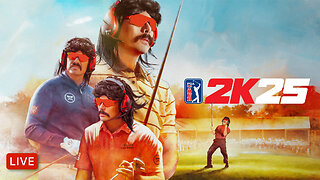Premium Only Content

Notes on the Ricercari
Ricercari in the 16th century: M.A. & G. Cavazzoni, de Paiva, Valente, de Cabezón &
Frescobaldi, Froberger, Storace, Krieger - Ricercari in the 17th century
Ricercari are contrapuntal instrumental pieces, mainly in the 16th and 17th centuries. Mostly they were composed for keyboard instruments or lute. Their structure sometimes corresponds to the motet, chanson and madrigal - they consist of several parts / sections that perform a soggetto, a small melodic theme.
The imitation ricercare leads to the fugue.
The term ricercare, associated with Italy and Germany, means to search; when improvising or composing, one searches for possibilities of thematic imitations.
Iberian composers do not use this term. De Paiva's Ricercare is an untitled piece of music without text that is easy to finger on keyboard instruments. De Cabezón's Tiento corresponds to a ricercar. In Italy, too, the terminology is not clear. Ricercare, fantasia, and sometimes also canzona and capriccio cannot be exactly separated.
Our examples come from different regions and sometimes have different titles. Also the notations in the sources are different.
Frescobaldi's Ricercari are printed as a four-part score.
Krieger's, Storace's, and M.A. Cavazzoni's ricercari are notated in modern-style piano systems.
Cabezón's music is notated in Spanish numeral tablature, and Valente's ricercare is notated in a modified form of numeral tablature.
Sources: Relevant articles from The New Grove, MGG, and Oesterreichisches Musiklexikon online.
---
Los ricercari son piezas instrumentales contrapuntísticas, principalmente de los siglos XVI y XVII. En su mayoría fueron compuestas para instrumentos de teclado o laúd. Su estructura corresponde a veces al motete, la chanson y el madrigal: constan de varias partes/secciones que interpretan un soggetto, un pequeño tema melódico.
La imitación del ricercare conduce a la fuga.
El término ricercare, asociado a Italia y Alemania, significa buscar; al improvisar o componer, se buscan posibilidades de imitaciones temáticas.
Los compositores ibéricos no utilizan este término. Ricercare, de De Paiva, es una pieza musical sin título y sin texto que resulta fácil de digitar con instrumentos de teclado. El Tiento de Cabezón corresponde a un ricercar. También en Italia la terminología no está clara. Ricercare, fantasía, a veces también canzona y capriccio no se pueden separar exactamente.
Nuestros ejemplos proceden de distintas regiones y a veces tienen títulos diferentes. Las anotaciones en las fuentes también difieren.
Los Ricercari de Frescobaldi se imprimen como una partitura a cuatro voces.
Los ricercari de Krieger, Storace y M.A. Cavazzoni están anotados en sistemas pianísticos de aspecto moderno.
La música de Cabezón está anotada en tablatura numérica española y la de Valente en una forma modificada de tablatura numérica.
Fuentes: Artículos relevantes de The New Grove, MGG y Oesterreichisches Musiklexikon online.
https://youtu.be/DTkvWxLDAk4
https://youtu.be/qvMY5SsHNvE
https://rumble.com/vkqm7v-ricercari-in-the-16th-century-m.a.-and-g.-cavazzoni-de-paiva-valente-de-cab.html
https://rumble.com/vlbr5u-frescobaldi-froberger-storace-krieger-ricercari-in-the-17th-century.html
-

Adam Carolla
3 hours agoHealth Insurance Executive sues John Oliver for destroyed reputation + Remembering Val Kilmer #news
8.49K1 -

TimcastIRL
3 hours agoTrump Signs GLOBAL Tariffs, Trade War Goes NUCLEAR As Market TANKS w/Mark Mitchell | Timcast IRL
152K49 -
 LIVE
LIVE
Alex Zedra
2 hours agoLIVE! New Stream Room!!!
948 watching -
 LIVE
LIVE
Akademiks
1 hour agoDay 1/30 Kanye West Interview Part 2 OTW. Young Thug Probation REVOKED? Lil Baby Putting Hits on Ppl
6,110 watching -
 LIVE
LIVE
Man in America
8 hours agoPam Bondi Wants the DEATH PENALTY—But Was Mangione FRAMED? The Evidence Will SHOCK You
984 watching -
 1:30:51
1:30:51
Glenn Greenwald
6 hours agoSubstack CEO on Protecting Writers from Speech Crackdowns; Week in Review: Matt Taibbi's Censorship Hearing Testimony, Fascism Expert Flees the U.S., and More | SYSTEM UPDATE SHOW #433
112K81 -

Dr Disrespect
12 hours ago🔴LIVE - DR DISRESPECT - PGA TOUR 2K25 - ONLINE RANKED UNDEFEATED
135K23 -
 1:59:49
1:59:49
2 MIKES LIVE
7 hours ago2 MIKES LIVE #200 It's our 200th Show with guests Paul Kanitra and Dan Nunn!
32.5K7 -
 21:41
21:41
JasminLaine
4 hours agoCarney HUMILIATED—Danielle Smith DESTROYS 'Garbage Polls' & Trump RUINS His Plan
36.5K22 -
 UPCOMING
UPCOMING
Film Threat
6 hours agoSUPERMAN! DISNEY! DRAGONS! LIVE FROM CINEMACON! | Film Threat After Dark
4.36K1